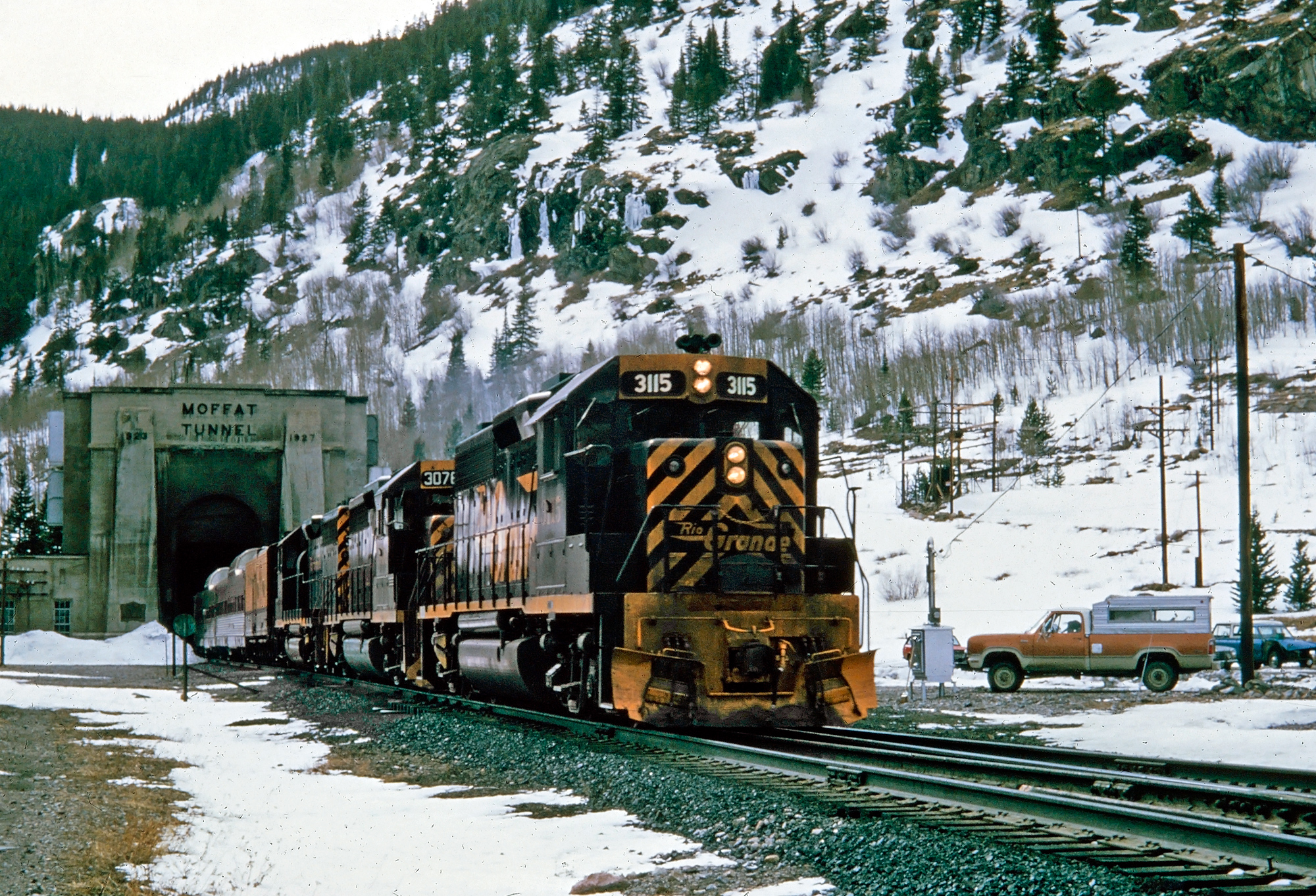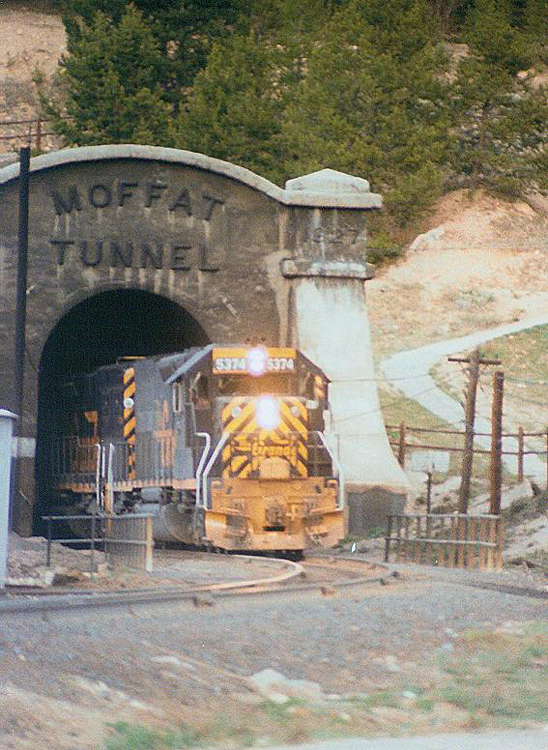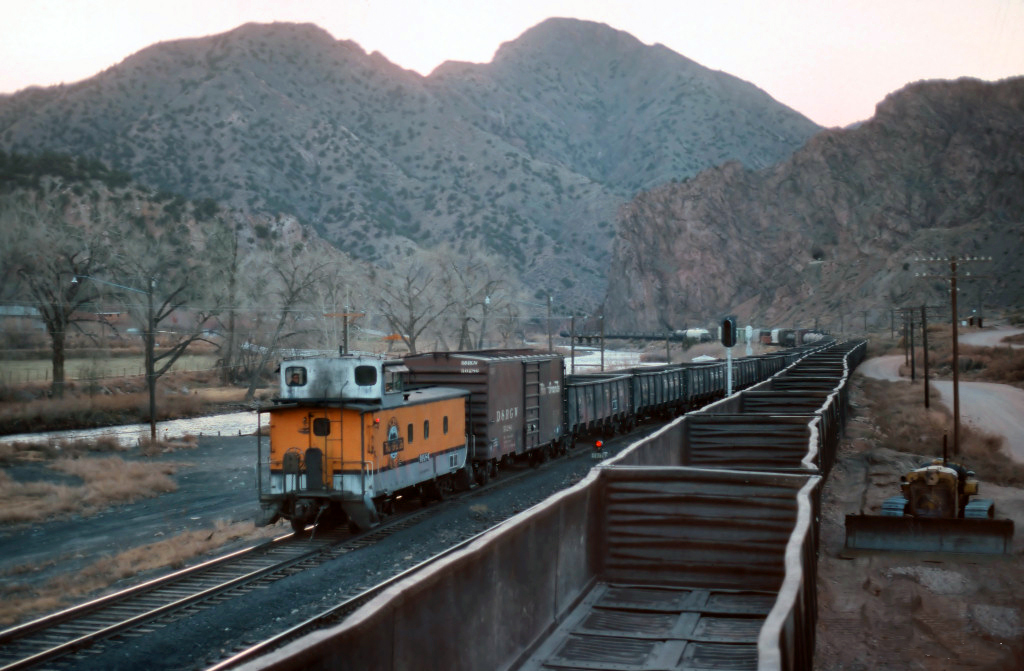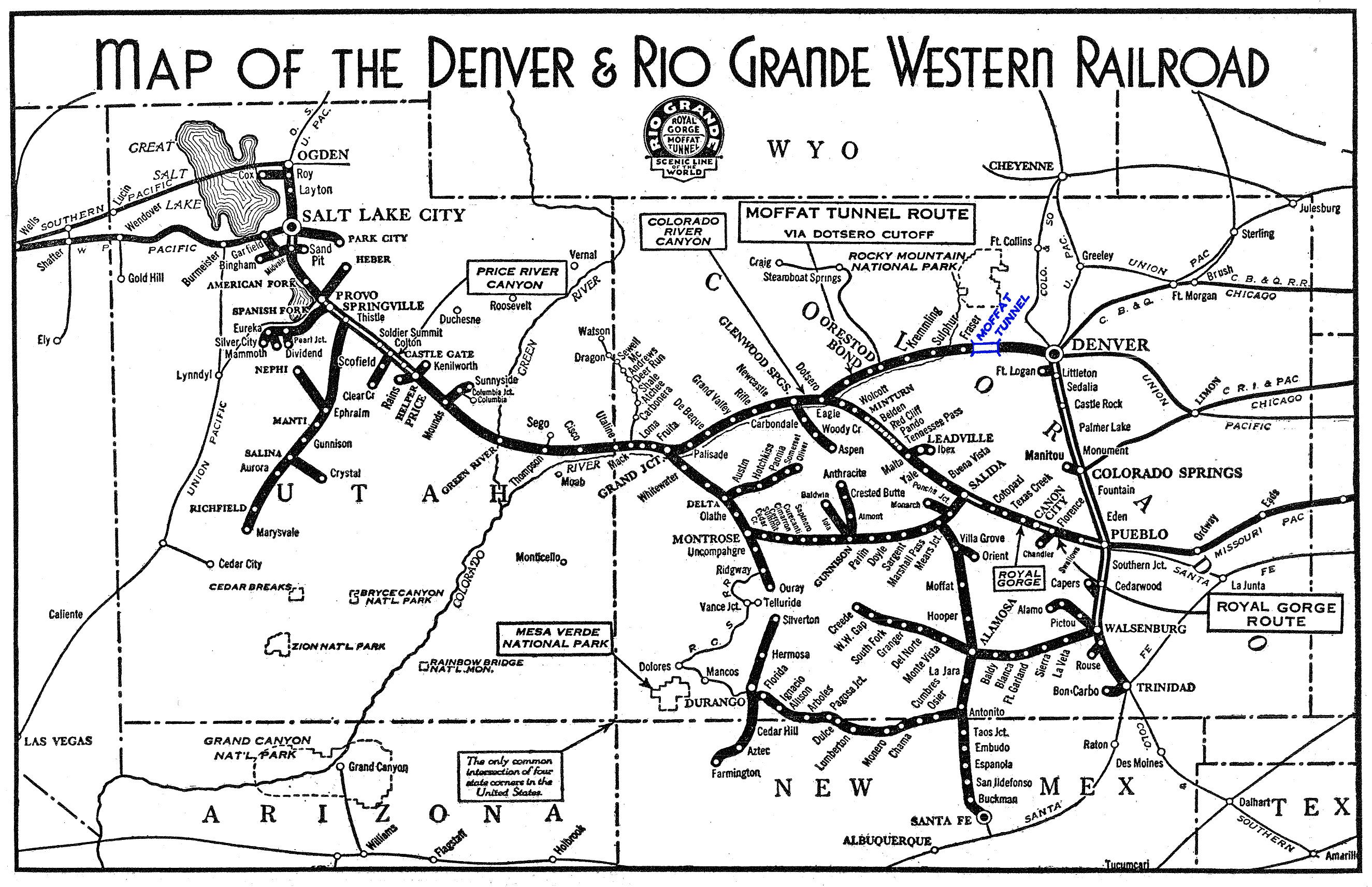Moffat Tunnel: The Majestic, 6.2-Mile Bore Beneath James Peak
Last revised: October 11, 2023
By: Adam Burns
While Moffat Tunnel is best known as one of the Rio Grande's most iconic locations it was actually the vision of businessman and entrepreneur David Moffat.
The tunnel, sitting at an elevation of 9,239 feet, was intended to be a link between Denver and Salt Lake City while passing through the Continental Divide.
The project not only eliminated many miles of superfluous trackage but also reduced grades of over 4%. Today the tunnel is owned by Union Pacific and remains an important component of its network through the Rocky Mountains.
The Moffat Tunnel is located 50 miles west of Denver, Colorado. It starts near Rollinsville on the east and ends near Winter Park on the west.
Photos
 Rio Grande GP40-2 #3115 leads the eastbound "Ski Train" out of the east portal of Moffat Tunnel on March 30, 1974. Gerard Putz photo. American-Rails.com collection.
Rio Grande GP40-2 #3115 leads the eastbound "Ski Train" out of the east portal of Moffat Tunnel on March 30, 1974. Gerard Putz photo. American-Rails.com collection.Denver & Salt Lake Railway
The 6.2-mile Moffat Tunnel was actually not built by the Denver & Rio Grande Western. Instead, the massive project was carried out by David Moffat's Denver & Salt Lake Railway
The history of this system dated as far back as the Denver, Northwestern & Pacific Railway of 1902. However, the DNW&P fell into bankruptcy in 1912 and was first renamed as the Denver & Salt Lake Railroad before becoming he Denver & Salt Lake Railway (D&SL).
Moffat had holdings and interests in numerous rail projects over the years, all of which were located in or around the state of Colorado. He initially hoped the Denver, Northwestern & Pacific would act as a low-grade "Air Line" linking Salt Lake City with Denver.
Such a corridor had been requested by the city of Denver but the resulting bankruptcies dimmed hopes the project would actually be completed. While Moffat spent all of his fortune trying to complete the route it never came to fruition before his passing.
By the time of his death the D&SL had only been finished between Denver and Craig, a distance of just over 200-miles. The route went over, and not through, the Rocky Mountains with grades topping out at over 4% along many stretches of the then-completed 23 miles.
 Rio Grande SD40T-2 #5374 exits from the west portal of Moffat Tunnel with a westbound freight train on May 23, 1977. Doug Kroll photo.
Rio Grande SD40T-2 #5374 exits from the west portal of Moffat Tunnel with a westbound freight train on May 23, 1977. Doug Kroll photo.Construction
It was the highest main line railroad ever built in the United States, reaching a height of 11,680 feet at the top of pass, and resulted in the D&SL having astronomical operating costs to move a single train over the line.
Construction on what became Moffat Tunnel began on July 6, 1923, mostly financed by the city of Denver and state of Colorado, which need to efficiently connect the city of Pueblo which had recently been devastated by flooding.
At A Glance
Initial estimates for the tunnel, which passed under James Peak of the Rocky Mountain Range, proved far too low. For instance, poor and unstable rock deposits on the west end of the bore drove up construction costs and it took the state three additional bonds to finally complete the tunnel.
By the time the project was finished, it totaled a staggering $23.9 million in 1920s value. With inflation and economic trends into account, this would equate to well over $370 million in today’s dollars.
The bore was "holed through" on July 7, 1927 although several months passed before the tunnel officially opened to rail traffic on February 26, 1928.
Map (1940)
Ventilation
Railroad tunnels several thousand feet in length require ventilation to both prevent asphyxiation by crew members/passengers as well as provide clean air to a diesel engine's intake.
The tunnel utilizes a system whereby canvas doors are kept closed to keep fresh air circulated throughout the bore. These doors are connected to a circuit which is connected to the track and once a train trips this circuit (roughly 8 seconds before it reaches the east or west portal) the door will open.
Today, the ventilation system is entirely computer controlled and monitors the particulate level within the tunnel; once this has fallen below the threshold Union Pacific has set, a train is cleared to enter.
During peak coal traffic through the early 2010s, upwards of 24-28 trains passed through Moffat Tunnel each day. This resulted in a bottleneck as the tunnel needed 20-25 minutes to purge the diesel exhaust before the next train could enter. Today, the line is no longer at capacity and most trains do not have to wait before entering.
 A Rio Grande caboose tags along at the end of a manifest freight rolling through Canon City, Colorado during November of 1976. Gary Morris photo.
A Rio Grande caboose tags along at the end of a manifest freight rolling through Canon City, Colorado during November of 1976. Gary Morris photo.Cost
The tunnel was originally estimated to cost $6.62 million. However, for the construction's difficulty resulted in the final total being nearly four times higher at $23,972,843. The project had also cost 28 workers their lives .
Moffat Tunnel not eliminated 23 miles of steep and dangerous railroad it also cut down operating times by hours.
In 1931 the D&RGW took over the Denver & Salt Lake's subsidiary the Denver & Salt Lake Western and used the railroad to complete the Dotsero Cutoff near the tunnel, further reducing grades and transit times.
Although the D&RGW fell into bankruptcy in 1935 it emerged in 1947 with ownership of the D&SL itself.
While the Rio Grande became part of the Union Pacific in 1996 through its purchase of the Southern Pacific the Moffat Tunnel continues to be an important artery today carrying not only freight trains but also Amtrak's California Zephyr.
Legacy
With a ruling grade of 0.8 percent through the tunnel, it offers a gentler and more straightforward path for trains to traverse the Continental Divide in comparison to other routes.
Currently, Moffat Tunnel remains an essential artery for both freight and passenger transportation. Private automobiles cannot use the tunnel, but the Winter Park Express ski train and Amtrak’s California Zephyr regularly utilize the tunnel in their routes.
Post-construction, the high maintenance cost presented a challenge. Keeping up with the ventilation, constant repairs due to freezing and thawing, leaking water, and ice building in the winter led to significant maintenance expenses
David Moffat had initially planned a tunnel through the Continental Divide as early as 1902. He ran short of funds, and his plans of the tunnel undulated for years until Federal assistance arrived in the form of a loan granted through the Railroad Act of 1921.
Even though David Moffat never lived to see his vision turned into reality, his influence over the project was significant. The tunnel was named in his honor as the Moffat Tunnel.
The Denver and Salt Lake Railway did more than just breathe life into Moffat’s tunnel dream. They also extended the rail to Salt Lake City, capitalizing on the tunnel's efficacy and transforming Denver into a critical juncture in the western railroad networks.
Due to its high elevation, the tunnel's eastern approach is susceptible to avalanches. Over the years, several avalanche sheds and deflection structures have been built to protect this section of track.
While the importance of the Moffat Tunnel for rail traffic cannot be overstated, it also serves another purpose. Water diversion—specifically, a pipe built into the structure—transfers water from the westward-flowing Colorado River to eastern cities, playing a vital role in irrigation and urban water supplies.
Despite its near-century old status, the Moffat Tunnel still stands as a testament to human ingenuity and endeavor. With continued maintenance, upgrades, and support from Union Pacific, it remains a vital conduit for transportation and water diversion.
The Moffat Tunnel was, in many ways, David Moffat's gift to the state of Colorado. It provided a faster, safer, and more economical passage through the Rockies, solidifying Denver's status as the hub of western American railway service.
To summarize, the Moffat Tunnel's story is a tale of vision, determination, technological prowess, and economic endurance. Today, it continues to serve as a critical component of America's transportation infrastructure and a tribute to the ambitious vision of David Moffat and the Denver and Salt Lake Railway.
SteamLocomotive.com
Wes Barris's SteamLocomotive.com is simply the best web resource on the study of steam locomotives.
It is difficult to truly articulate just how much material can be found at this website.
It is quite staggering and a must visit!

